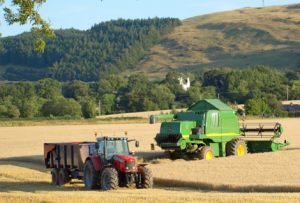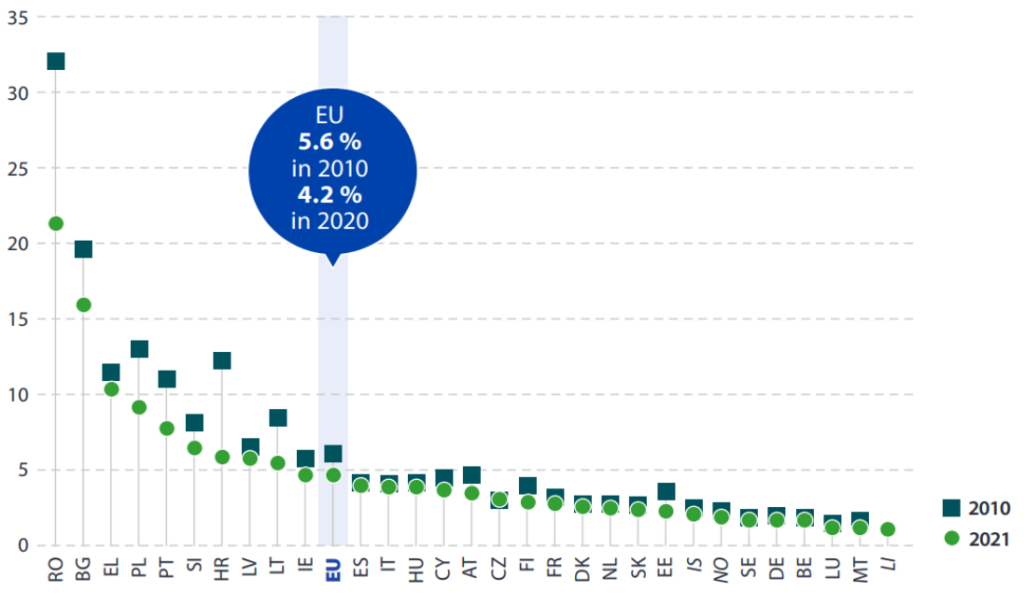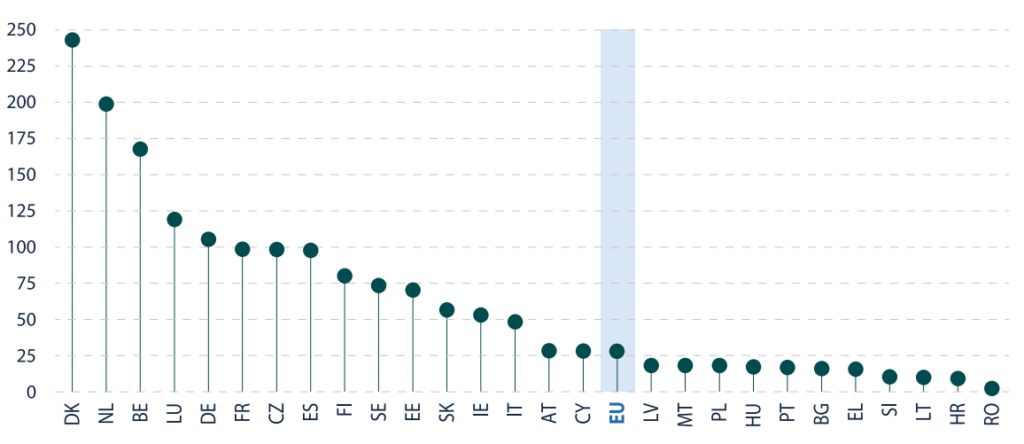The fields in which Romania ranks in European agricultural charts are not few, our country contributing significantly at continent level to the EU agricultural production. However, its potential is much higher, according to the analysis on the field made by Eurostat.
It must be stated foremost that Romania stands out with the highest number of persons engaged in agriculture compared to the EU member states. At EU level, 8.7 million persons were engaged in agriculture (including hunting and related services), the equivalent of 4.2% of the total EU employees. Agriculture employment has decreased along with the number of farms.
The share of agriculture employment in the EU dropped from 5.6 % in 2010 to 4.2 % in 2020. Agriculture represented a very large share of total employment in Romania – more than one in five persons (21%) working in this sector in 2020. The share of agriculture in the total employment is also relatively high in Bulgaria (15.5 %) and Greece (9.9 %).
Romania has the largest share of people working in agriculture in the EU
However, this was less than 1% of the total population in Luxembourg and Malta (0.7 % in both). Between 2010 and 2021, the share of agriculture in total employment decreased in every EU state.
Between 2010 and 2021, Romania registered the biggest drop in agriculture employment (-11%), followed by Croatia (-6.4%).
Small farmers support European agriculture
European agriculture is dominated by “family farms”, a term which defines farms owned and managed by the members of a family providing more than half of the agricultural labor force.
Family farms are by far the most common type of farm in the EU; the majority are small semi-subsistence farms, employing only family members, and farms that must rely on other lucrative activities as well for diversified income, although some are larger and more productive.
The vast majority (95%) of total EU farms were classified as family farms in 2020.
Romania, followed by Greece, have the highest share of family farms, with over 99% of the total. Moreover, family farms represented more than four fifths of the total farms in most member states, with the exception of Estonia (65.2 %) and France (57.6 %).
Romania, among the main EU grain producers
In 2022, the area cultivated with grain in the EU was 51.5 million hectares, from which 271 million tons of grain was harvested. France represented little more than one fifth (22.1 %) of the EU grain production 2022, while Germany (16.1 %) and Poland (12.9 %) held the following positions in terms of production.
Romania’s grain output was 18.9 million tons, representing 7% of the EU total.
Most of EU’s grain is grown on the vast plains in France, Germany, Poland, Romania and Spain. In 2022, the durum wheat harvested production was mainly focused in Italy (where it is used in making pasta), while the production of rye and oats (used in making bread, vodka and animal feed) was focused in Germany and Poland.
Besides Poland, Finland and Spain, countries that registered the highest levels of oats production, Sweden and Ireland were also relatively specialized in such productions, since this type of grain tends to thrive in colder and more humid conditions.
Romania, large producer of maize
France, Poland and Romania were the main producers of maize, while Italy and Spain were the main rice producers in the EU.
2022 was characterized by a poor grain harvest, Romania being the most affected by drought (-32.1%, a lower harvest by 9 million tons); France registered a 7 million tons drop (-10.4%), Spain (-24,4 %; a drop of 6.2 million tons) and Hungary (-35.2 %; a drop of 4.9 million tons).
Romania, slacker in terms of vegetable production
In 2023, the EU potato harvest from 1.4 million hectares was 46.6 million tons, including seed potatoes. Romania, with a harvest of 1.4 tons held the 8th position, with 3% of the total production.
Germany is the largest potato producer in the EU, with 23% of the total, followed by France, (17%), the Netherlands (14%) and Poland (12%).
Romania is not in the top of vegetable producers either, where Spain is the largest producer, holding 23.7% of EU production, followed by Italy (21%). The production of certain types of fresh vegetables is mainly concentrated in several EU member states. For instance, Italy represented nearly two fifths (40%) of the tomato production harvested in the EU in 2022.
The Netherlands (24.2% of EU production) and Spain (20 %) were the main onion producers, while Germany (17.7 % of the EU total) had the largest share in the carrot production.
Romania produces half of EU plums
The EU produces a wide range of fruit. A total of 25.4 million tons were harvested in 2022 (excluding citrus, grape and strawberry), of which 14.7 million tons were fruit with seeds (apples and pears), 6.3 million tons were drupes (such as peaches, nectarines, apricots, cherries and plums), 2.6 million tons were subtropical and tropical fruit (such as figs, kiwi, avocado and banana), 1.1 million tons were nuts and 0.7 million tons were berries (others than strawberries).
In 2022, Italy (21.6 %), Poland (20.3 %), Spain (13.9 %) and France (11.2 %) were the main producers of fruit, berries and nuts in the EU.
Regarding specific fruit, other EU member states were key players, like the Netherlands and Belgium in terms of pears.
Romania is first in the EU concerning plum production, holding nearly half of the Union’s output (45.2%)
Number 6 in terms of wine production
According to OIV, in 2023, our country produced 4.4 million hectoliters of wine, 15% more than in 2022 and 4% more than the average of the last 5 years, strengthening its position as the sixth largest wine producer in Europe. Volume increases worldwide were also recorded by the USA (25.5 million hl, 12% more than in 2022), Portugal (7.4 million hl, +8%) and Germany (9 million hl, +1%).
Due to climate conditions, drought and vine disease, wine production in the southern hemisphere was severely affected, but Europe also registered some sharp drops of wine production volume. Especially affected were Greece (-50%), Croatia (-46%), Georgia (-28%), Spain (-19%), Italy (-13%) and Moldova (-10%).
Second sheep breeder in the EU
The EU has a sizeable population of domestic animals: at the end of 2022, EU farms recorded 134 million pigs, 75 million bovines and 70 million sheep and goats.
The majority of animals in the EU are held by just some of the member states. Spain held approximately one quarter of the population of pigs (25.4%), sheep (24.5%) and goats (21.8%) in the EU in 2022, while Greece registered a somewhat larger share of the EU goat population (26.2%), and France held 22.7% of the bovine population.
Romania is second in terms of sheep breeding (17.4%) and third among goat breeders in the EU, with 13% of the total.
Subsistence farms are the animal breeders in Romania
A standard unit is used in order to calculate the size of a livestock farm. This is a reference unit that facilitates the aggregation of animals of various ages and species. The reference unit (=1 LSU) is the grazing equivalent of an adult dairy cow producing 3,000 kilograms of milk annually, without addition concentrated feed. Based on this measure, there were 113.4 million livestock units in the EU in 2020. France (19.0 million LSU), Spain (16.6 million LSU) and Germany (16.3 million LSU) were the largest holders. A relative measure of livestock farm size is defined as the number of livestock units per farm.
The smallest animal farms in the EU
On average, there were 28 livestock units per farm in the EU in 2020. The largest average sizes among EU member states were in Denmark (243 livestock units per farm), the Netherlands (199) and Belgium (168). At the other end of the spectrum, there were on average fewer than 10 livestock units per farm in Croatia and Romania (where semi-subsistence livestock rearing on relatively small farms tends to be predominant).
Cheeses, the most valuable products of the EU food industry
The food industry in the EU produces a wide range of foods and drinks, from products that can be considered luxury items to high value ones. Subsequently, unprocessed cheese – including specialties such as Brie, Edam, Feta or Gorgonzola – was the product category with the highest value in European agriculture (EUR 42 billion) in 2022. These products are very valuable for dairy farms.
Bread and beer held the second and third positions respectively in terms of value, registering productions of EUR 33.8 billion in 2022, and EUR 32 billion, respectively. These products are important to grain producers, especially those who grow wheat and rye for bread, and barley for beer. Germany was the leading EU producer of both products, with considerably higher shares than any other EU state, with 35% of bread production and 19% of beer production.
Three other product groups where production value exceeded EUR 25 billion in the EU in 2022 were: soft drinks (EUR 30.0 billion), cakes and pastries (EUR 27.8 billion) and sausages (EUR 26.6 billion).
Romania, in the top of sausage production value
The highest level of food industry production in the EU member states is found in 12 different product categories.
In terms of value, unprocessed cheese was the most important product for Italy, France, Greece and Estonia, while sausages had the highest production value in Poland, Austria, Romania, Slovakia and Slovenia.
In the Czech Republic and Croatia, beer had the highest production level among foodstuff. Germany was the only member state to report that fresh bread was its main foodstuff product, while Ireland and Sweden both reported the highest production level for fresh beef and veal. For Spain, the most valuable foodstuff product is virgin olive oil.
***













